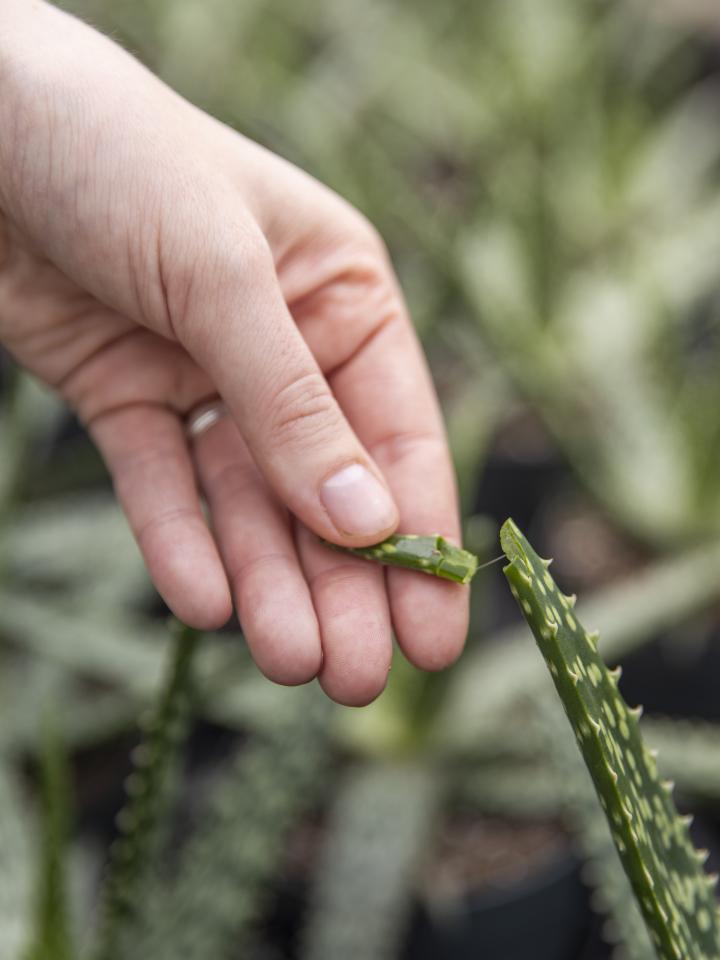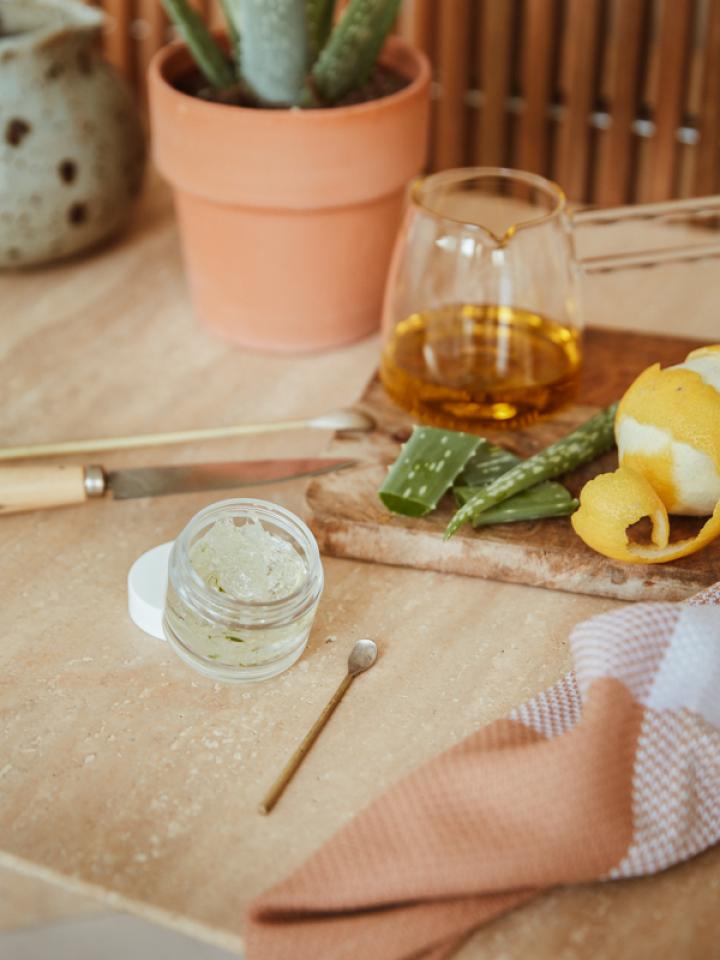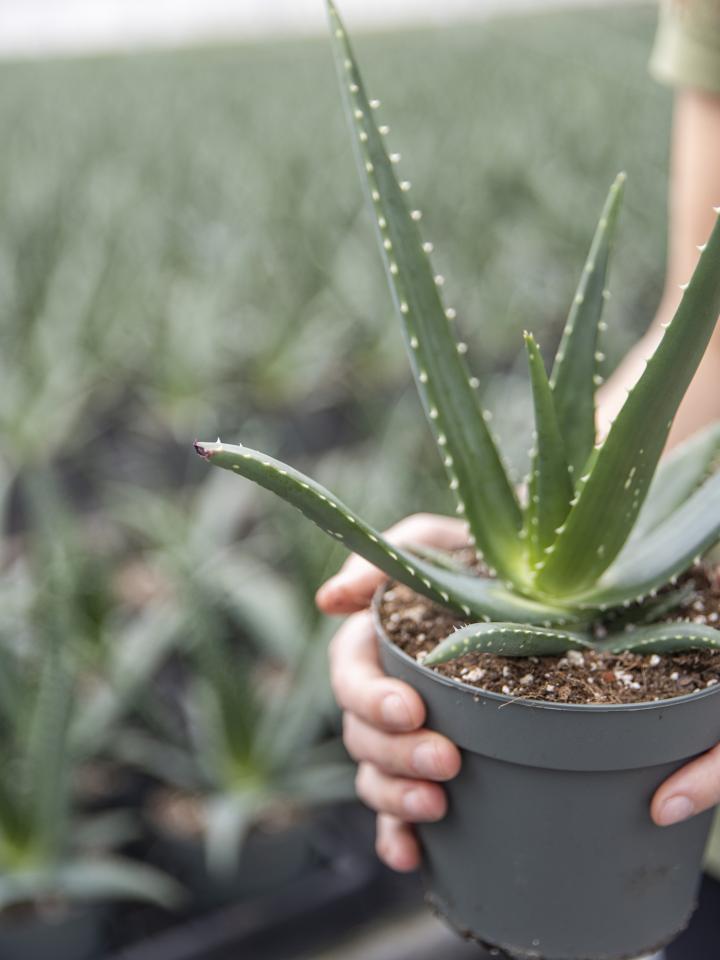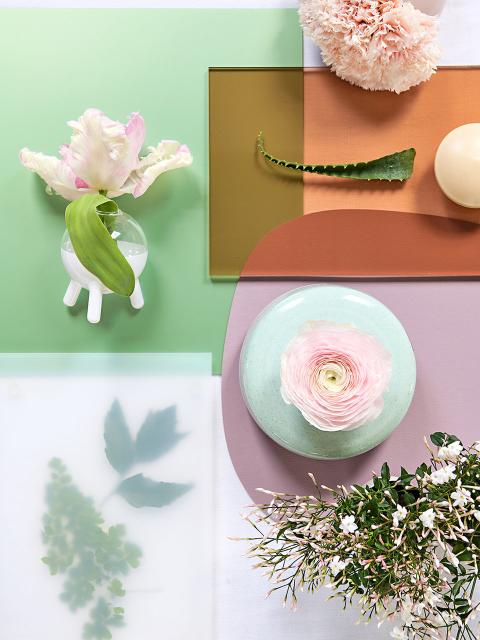Aloe Vera: characteristics and flowering
Aloe Vera is the best-known Aloe plant. This species has large, blue-green, thick and pointed leaves that usually grow 40 -100 centimetres high and grow upwards in points from a rosette. They have characteristic spines along the edges, which somewhat resemble small shark teeth. Aloe is a self-reliant plant, which stores moisture and nutrition in its stems. It can easily weather dry periods.
Aloe is a succulent plant belonging to the Asphodelaceae family, also called the Affodil family, which includes plants such as Tubular Tree and White Affodil. Aloe is an evergreen, non-winter hardy desert plant native mainly to Africa and countries around the Mediterranean Sea. In the wild, the plant blooms about 3 months a year, with yellow and red flowers. In your living room, an Aloe Vera plant is unlikely to bloom.
What types of Aloe are there?
There are over 300 different species of Aloe; Aloe Vera (botanical name Aloe barbadensis miller) is by far the most common and well-known. There are several species of Aloe, which vary in size and leaf shape. The most well-known species are:
- Aloe Vera (Aloe barbadensis miller): this is the most popular and well-known species, beloved for its succulent leaves with medicinal properties. This species is also called the ‘common’ Aloe Vera. Aloe Vera has grey-green, fleshy leaves with sharp edges. The leaves form a rosette and can grow to about 90 centimetres tall.
- Aloe Ferox: this species has erect, broad, dark green leaves that are sometimes a little prickly. This species grows up to 1 metre tall and contains resinous sap, which is widely used in the cosmetics industry. The sap also has laxative properties, so it's used for digestive problems.
- Aloe Arborescens: this species has a tree-like growth habit and can grow up to 2 metres tall. The leaves are long and narrow and grow up from the trunk. The juice of this species is often used in traditional medicine for its healing and anti-inflammatory properties.
- Aloe Saponaria: this species has short, thick leaves with white dots or stripes, giving the plant a ‘zebra’-like appearance. The leaves tend to be smaller than those of the common Aloe Vera. The juice of this species is used in cosmetics because of its supposed healing effect on the skin.

Aloe Vera: caretaking and location
If you're looking for an attractive houseplant that's easy to maintain, Aloe is a good choice. Once you have an Aloe, you'll want it to thrive in its new home Check out our tips below for location tips and caretaking advice for Aloe plants:
- Aloe likes a light, warm location. It can tolerate a spot in full sun, such as on a south-facing windowsill, but also thrives in a spot with some shade.
- Aloe is a succulent plant, which means it needs very little water. Water the plant only when the top layer of the potting soil feels dry. In summer, this can be every 2-3 weeks, and even less frequently in winter.
- Repot Aloe to a larger pot once every 2-3 years.
- You can give Aloe cactus food during the growth period (spring and summer). This promotes healthy and beautiful growth.
- During a warm, dry period (in the summer months), Aloe can survive happily outside. Note: preferably put the plant in a spot where it won't get too wet from summer rains, otherwise there's a risk of root rot.
Can Aloe Vera survive outdoors?
Whether Aloe Vera can survive in your garden depends on where you live. If your home is in a warm, dry climate, it's likely that the plant will do well outdoors. Aloe is not winter-hardy, however, and thus is less suitable for life outdoors in Britain. However, you can keep Aloe outside as a potted garden plant during warmer, drier summer months. Make sure the plant doesn't get too wet from summer rain, as this could cause rot. During the colder months, bring the Aloe back inside to stay warm and dry throughout the winter.

What are the beneficial properties of Aloe Vera?
Aloe Vera is a versatile plant that has multiple uses and beneficial effects. The leaves are the main parts used, with their gel and juice used in skincare and cosmetics products with softening properties. The gel contained in the leaves is used to soothe minor skin problems such as sunburn, burns and irritation. An extract taken from inside the outer lining of the leaves (aloe latex) can help to treat constipation. Aloe Vera peelings can also act as a natural pesticide.
What is Aloe Vera used for?
Aloe Vera has been popular for centuries because of its health-promoting properties. Aloe, but especially Aloe Vera, is known for its many uses in the pharmaceutical, food, and cosmetic industries. These are the main uses of Aloe Vera:
- Skincare: Aloe Vera gel is well-known for its moisturising and anti-inflammatory properties. The gel moisturises skin and helps reduce skin irritations such as sunburn, eczema and redness. Moreover, Aloe Vera stimulates wound healing and healing of burns and contains antioxidants such as vitamin C and E, which protect against free radicals and helps delay skin ageing.
- Cosmetics: Aloe Vera is often used in make-up removers, anti-aging products, hair care and after-sun products. This is because of its cooling, soothing, calming and moisturising properties.
- Medicinal applications: the antioxidants and vitamins in Aloe Vera support the immune system and can help fight infections. In addition, Aloe Vera has anti-inflammatory effects, so it can have positive effects on inflammations such as arthritis. Aloe Vera juice improves digestion and has a mild laxative effect. Aloe Vera juice could also help regulate blood sugar levels, which could be useful for people with diabetes.
- Nutrition: Aloe Vera juice is sold as a dietary supplement in the form of drinks and capsules. These can help improve detoxification and digestion.
- Alternative medicine: for centuries, Aloe Vera has been used to treat various conditions, such as skin problems and stomach ailments.
- Eco-friendly insecticide: many insects don't like Aloe Vera peel, so the plant can be used as a natural remedy to control certain insects.

Is Aloe Vera toxic?
Aloe Vera is not toxic to humans. Although the juice of Aloe Vera is used in certain foods, we do not recommend consuming the juice from your own Aloe Vera. For pets, the juice can be mildly toxic and cause digestive problems, so you should preferably keep the plant out of reach of pets such as dogs and cats.
Aloe Vera symbolism
Aloe is one of the oldest medicinal plants in the world. The Egyptians called Aloe Vera the ‘plant of immortality’, using it while embalming bodies. Today, the plant is also known as the ‘miracle plant’, because of its medicinal properties. Aloe not only symbolises immortality, but also vitality, happiness and positive energy. The plant is said to attract positive energy. An Aloe Vera that grows well attracts happiness.
When and how should you take Aloe Vera cuttings
It's easy to take Aloe Vera cuttings and propagate it. Read all about plant cuttings in this article, and check out our step-by-step plan for taking Aloe cuttings below:
General advice for propagating Aloe plants:
- You can take Aloe Vera cuttings all year round if you're keeping it as a houseplant. The best time to take cuttings is during the growth period (late spring/summer), as cuttings need a lot of sunlight and grow fastest and best during the warmer months.
- You can take the cuttings via leaf cuttings, but you have greatest chance of success if you separate young shoots from the mother plant (also known as taking offshoot cuttings).
Step-by-step plan for taking Aloe Vera cuttings
- Find a suitable offshoot, or small shoot, on your Aloe. Make sure the offshoots are about 20% the size of the mother plant to ensure they're strong enough to survive.
- Carefully take the mother plant from the pot, removing as much potting soil as possible so you can clearly see how the roots are arranged.
- Gently untangle the offshoot from the mother plant. If this isn't possible, carefully cut it loose from the mother plant with a sharp, clean knife instead.
- Plant the mother plant back into its pot and add fresh potting soil (or cactus soil) if necessary.
- See if the offshoot has roots already. The more roots, the more easily it will establish itself.
- Does the sprout have no roots? Let it dry on kitchen roll for a few days before putting it in potting soil (or cactus soil).
- Does the sprout have roots? Plant it immediately in a pot with potting soil (or cactus soil) and ensure the soil is slightly moist.
6. Make sure the cutting gets enough light. Place it on a sunny windowsill or outside under a canopy during a hot summer.

Where does Aloe Vera originally come from?
Aloe Vera has been growing on the Arabian Peninsula and parts of North Africa for thousands of years. As a desert plant, Aloe has to survive in an extreme climate, which is why it produces as many as 75 substances that help it do so. For example if a leaf is damaged, the ‘wound’ will immediately seal itself with coagulating sap to keep in as much moisture as possible, just like in humans.
The earliest mention of Aloe dates from Egyptian hieroglyphics (around 2200 BC). The Egyptians considered Aloe a sacred, immortal plant and used it for skin care and medicinal purposes. It was often used in treating wounds and embalming bodies. In classical antiquity, the Greeks and Romans used Aloe Vera for various ailments such as skin problems and digestive disorders.
Through explorations and trade, Aloe Vera became known in Europe, initially in the south. Spanish and Portuguese explorers introduced the plant to northern European countries and other continents. Soon the plant became popular worldwide for its many uses and decorative value. Today, Aloe is also found in countries around the Mediterranean Sea, Indonesia, Mexico and the Caribbean. Scientific research confirmed the health benefits of Aloe Vera, increasing its popularity. Today, the gel and juice are widely used in lotions, creams, supplements and drinks.
Where does the name Aloe Vera come from?
The name Aloe comes from the Arabic ‘Alloeh’ meaning ‘shiny, bitter substance’. This refers to the cooling gel-like liquid (the juice) in the leaves. ‘Vera’ means as much as ‘the one and only’. Hence, Aloe Vera is considered ‘the real Aloe’. In Arabia, Aloe is also called ‘saber’, meaning ‘patience’. It's a slow grower, but the plant does last for generations when cared for.
















